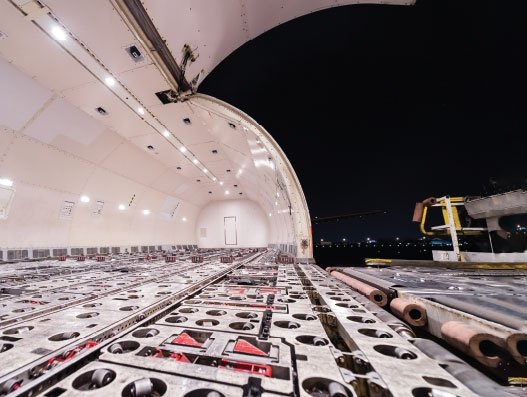
FROM MAGAZINE: Waiting to be filled air cargo continues to be in the doldrums
Global air cargo industry continues to suffer across all regions and the demand decline experienced in 2019 is the steepest drop since 2009 during the global financial crisis. Airline association IATA predicts that air cargo demand will increase by two percent in 2020; however there are several ifs and buts for the industry to get […]

Global air cargo industry continues to suffer across all regions and the demand decline experienced in 2019 is the steepest drop since 2009 during the global financial crisis. Airline association IATA predicts that air cargo demand will increase by two percent in 2020; however there are several ifs and buts for the industry to get back to growth momentum.
Presenting the International Air Transport Association (IATA) industry outlook at IATA’s Global Media Day in Geneva in December 2019, IATA’s chief economist Brian Pearce said: “Cargo is a leading indicator of how the industry is performing, and in 2019 we had a pretty miserable year.”
Global air cargo markets have had an extremely tough time in 2019 as a result of the trade war. Air freight demand, measured in freight tonne kilometers (FTKs), contracted by around 5 percent, the worst performance since the 2008-9 global financial crisis. Cargo traffic turned negative for the first time since 2012. Freight carriage, meanwhile, slipped to 61.2 million tonnes from 63.3 million tonnes in 2018. Cargo traffic is expected to rebound moderately with 2 percent growth in 2020, with tonnes forecast to reach 62.4 million, which is still below the 2018 result. According to IATA, yields will continue to slide with a 3 percent decline forecast for 2020, an improvement from a 5 percent decline in 2019. Cargo revenues will slip for a third year in 2020 with revenues expected to total $101.2 billion, down 1.1 percent from 2019.
“Demand is set to decline in 2019 overall — the weakest annual outcome since the global financial crisis,” said Alexandre de Juniac, CEO, IATA CEO. “It has been a very tough year for the air cargo industry,” the IATA chief added.
IATA’s forecast is based on the assumption, similar to that of the IMF and WTO, that ahead of the US elections there will be a “truce” with no reduction in existing tariffs but no additional tariffs either. If so, then stronger economic growth in 2020 will produce a modest rise in international trade growth from 0.9 percent in 2019 to 3.3 percent in 2020. This pace of trade growth in relation to 2.7 percent global GDP growth is still exceptionally low in comparison with the typical two times relationship that existed before the global financial crisis. This, according to IATA, will support air cargo industry moderately.
Interestingly, the air cargo industry began to show signs of emerging from its slump towards the close of 2019. IATA did suggest there are glimmers of a turnaround in some of the economic indicators. For one, international trade volume indicators began to show improvement in September. It said the new export orders measured in the Purchasing Manager Index, which is still down year-over-year, however is showing its best numbers since 2018.
Data from WorldACD showed that cargo demand in chargeable weight declined by 2.5 percent in November, an improvement on declines of 6.9 percent in August, 5.3 percent in September and 4.7 percent in October. Meanwhile load factors have climbed steadily since August, improving by 2 to 2.5 percentage points in September, October and November.
“If the trend continues, the month of December may be the first month in 2019 showing no year-on-year (YoY) decline… But even if December YoY would turn out to be ‘neutral’, the worldwide volume for the full year 2019 will be 4.3 percent [lower than] 2018,” noted WorldACD in its analysis.
The most striking feature in the November results, according to WorldACD, was the ongoing growth in China and Hong Kong. The two origins taken together for the months of October and November, increased their outgoing volumes by 4.6 percent compared with the year 2017 and by 5.1 percent compared with 2018. Main engines behind this growth are the destinations Europe and the Middle East & South Asia, but exports to North America decreased. High-tech was the fastest growing product category ex China and Hong Kong.
Worldwide, special cargo continued to grow, recording its highest growth in November: +4.2 percent YoY. The positive outlier in Europe’s performance this year has been Northern Europe, showing an 11.6 percent YoY growth, largely driven by a phenomenal growth from Norway of more than 20 percent. Norway’s export by air consists for more than 80 percent of fish and seafood, 2/3 of which goes to the Asian countries. The Norwegian Seafood Council attributes this growth to an increased demand for – in particular – the healthy “fatty fish” types like salmon and mackerel.
Political unrest and trade disputes between key economies continue to be a hurdle for the air freight industry growth. By now it is sure that cargo revenues will slip for a third year in 2020, the forecast suggests, and while Asia-Pacific, the biggest region for airborne exports, should show an upturn in earnings. Britain’s exit from the European Union may also be problematic for the freight sector, creating increased paperwork and potentially weighing on UK shipments as the economy comes under pressure.
“The trade tensions that persist between several major economies – and the accompanying GDP growth slowdown – have had more impact on the airfreight industry,” said Angela Gittens, director general of Airports Council International (ACI).
According to ACI, North America was the only major region with a positive, albeit marginal, year-to-date growth rate, having gained 0.5 percent for the first six months of this year – a result which is more than four percentage points above the Europe and Asia-Pacific regions. The domestic market drove North America’s performance, having gained 4.1 percent year-to-date, in comparison with a minus 4.4 percent in its international market.
Among the worst affected is the Asia-Pacific region which continued its decline in June, with total cargo volumes down by 6.5 percent, bringing its year-to-date growth rate to minus 5.9 percent. Both of its freight market segments were negative for the first half of 2019, at minus 3.6 percent for the domestic sector and minus 6.7 percent for international shipments.
Africa’s airfreight industry was, along with North America, one of the two regional markets with positive growth in the first half of 2019. Meanwhile, the previously buoyant Middle East air cargo market dropped by 7.1 per cent in June, bringing that region’s year-to-date growth rate to minus 2.7 per cent.
“Slowing economic growth, trade wars, geopolitical tensions and social unrest, plus continuing uncertainty over Brexit all came together to create a tougher than anticipated business environment for airlines,” said Juniac of IATA. “Yet the industry managed to achieve a decade in the black, as restructuring and cost-cutting continued to pay dividends. It appears that 2019 will be the bottom of the current economic cycle and the forecast for 2020 is somewhat brighter,” he added.
However, freight agents are cutting their block space agreements with airlines for 2020, as they are unwilling to commit volume to carriers in a dismal air cargo market that shows little signs of recovery. While airline industry group IATA predicts a somewhat brighter future for the air cargo industry in 2020, the same is not the sentiment among freight forwards and airline customers. Forwarders are of the opinion that the erosion of long-term volume contracts was having serious consequences for airlines that relied on the safety net of volume on which to build budgets and forecasts.
Speaking at the annual executive summit of The International Air Cargo Association (TIACA) in Budapest, Hungary, Steven Polmans, chairman of TIACA, said that the weak market will extend to the second half of 2020. “The first six months of 2020 will be difficult before we see an improvement in demand in the second six months,” said Polmans, who is also the director of cargo and logistics at Brussels Airport Company. Speaking to The STAT Trade Times recently Polmans said that he is not extraordinarily concerned about the current stress the industry is going through. “We have had a few good years in the past and we can’t expect every year to be good. Lot of underlying factors are not as bad as we think. Certainly, the uncertainty is not helping us at all.”
We are already into the new decade and into 2020 and the reality is market conditions continue to be challenging and tough for air cargo industry world over.
This feature was originally published in STAT Trade Times' January 2020 issue.

